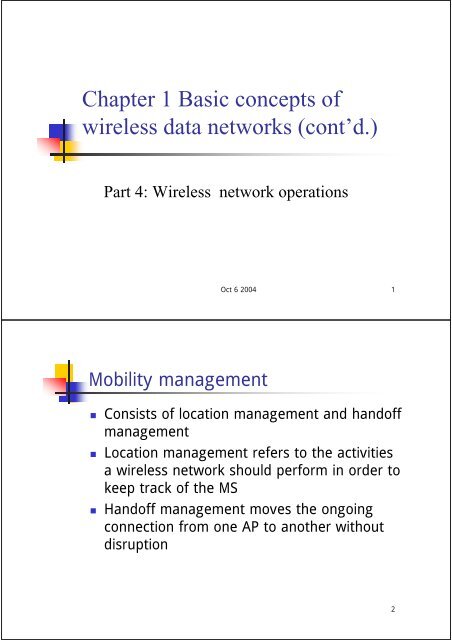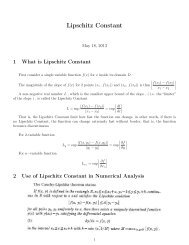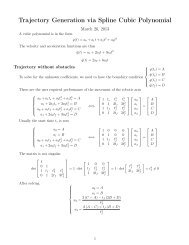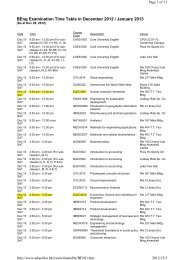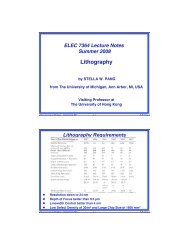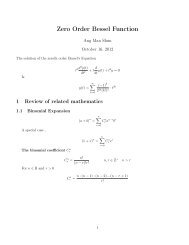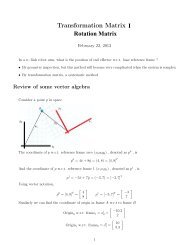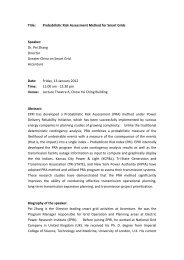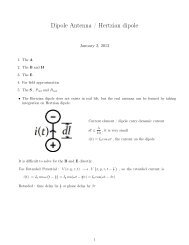Chapter 1 Basic concepts of wireless data networks (cont'd.)
Chapter 1 Basic concepts of wireless data networks (cont'd.)
Chapter 1 Basic concepts of wireless data networks (cont'd.)
Create successful ePaper yourself
Turn your PDF publications into a flip-book with our unique Google optimized e-Paper software.
<strong>Chapter</strong> 1 <strong>Basic</strong> <strong>concepts</strong> <strong>of</strong><br />
<strong>wireless</strong> <strong>data</strong> <strong>networks</strong> (cont’d.)<br />
Part 4: Wireless network operations<br />
Oct 6 2004 1<br />
Mobility management<br />
• Consists <strong>of</strong> location management and hand<strong>of</strong>f<br />
management<br />
• Location management refers to the activities<br />
a <strong>wireless</strong> network should perform in order to<br />
keep track <strong>of</strong> the MS<br />
• Hand<strong>of</strong>f management moves the ongoing<br />
connection from one AP to another without<br />
disruption<br />
2
Location management<br />
• Functionality <strong>of</strong> location management:<br />
• Track the location <strong>of</strong> the MS<br />
• Determine the status <strong>of</strong> the MS<br />
• Location management consists <strong>of</strong> three parts:<br />
• Location update: MS sends messages regarding its<br />
changing points <strong>of</strong> access to the network<br />
• Paging: for the network to locate the MS to a<br />
particular cell<br />
• Location information dissemination: store and<br />
distribute the location information related to the<br />
MSs serviced by the network<br />
• <strong>Basic</strong> issue: trade<strong>of</strong>f between update and<br />
paging<br />
3<br />
Location update algorithms<br />
• Two types:<br />
• Static: network topology decides when updates<br />
are to be sent<br />
• Dynamic: mobility, call patterns are used for<br />
initiating location updates<br />
• Location area: several cells grouped into an<br />
LA with the same LA id<br />
• Each BS broadcasts this LA id<br />
• Location update is sent when MS receives a new<br />
LA id<br />
4
Static location update<br />
5<br />
Location update in GSM<br />
• Several cells controlled by the same<br />
BSC form an LA<br />
• Three cases for MS to update location:<br />
• Upon powering up, receives a different LA<br />
id with stored one<br />
• Crosses a boundary <strong>of</strong> LA<br />
• After a period <strong>of</strong> time predetermined by<br />
network<br />
6
Location area with ping-pong effect<br />
• Problem: MS frequently crosses the boundary <strong>of</strong> two<br />
LAs<br />
• Solution: dwell timer employed, update only when<br />
the MS has stayed in the new LA long enough<br />
7<br />
Dynamic location update<br />
• State-based location update<br />
• Update decision is based on current state<br />
information<br />
• Time elapsed, distance traveled, no. <strong>of</strong> LAs crossed, no.<br />
<strong>of</strong> calls received, etc.<br />
• User-pr<strong>of</strong>ile-based update<br />
• A sequential list <strong>of</strong> LAs the MS may move to is<br />
maintained<br />
• Location update needed only when the MS moves<br />
to a new LA not on the list<br />
8
Paging schemes<br />
• Paging: broadcasting a message in a cell or a<br />
group <strong>of</strong> cells to elicit a response from the MS<br />
• Paging only the cell where the MS is located,<br />
reduce the cost <strong>of</strong> paging: very difficult<br />
• Blanket paging in GSM<br />
• Paging the MS in all cells within an LA<br />
• Advantage: delay is kept to be minimum<br />
• Disadvantage: paging is done in several cells<br />
• “Closest-cells first” paging: the cell where the MS<br />
was last seen is paged first, followed by<br />
subsequent rings <strong>of</strong> cells<br />
• Timeout is used to declare the MS as unreachable<br />
9<br />
Location information dissemination<br />
• Anchor is used for storing MS location<br />
information<br />
• Several anchors employed for decreasing loading<br />
and improving reliability<br />
• Each MS is associated with a home <strong>data</strong>base<br />
• User pr<strong>of</strong>ile like mobile id, location, accounting,<br />
etc. stored in home <strong>data</strong>base<br />
• User location is maintained in terms <strong>of</strong> visiting<br />
network which is currently serving the MS and<br />
visiting <strong>data</strong>base<br />
• Disadvantage: paging is done in several cells<br />
10
Location information dissemination in<br />
GSM<br />
• Home and visiting <strong>data</strong>base are called home<br />
location register (HLR) and VLR<br />
• When MS observes a change on LA, location<br />
update sent to MSC<br />
• MSC contacts its VLR<br />
• If VLR serves both old and new LA, nothing is<br />
done<br />
• If the VLR has no information about this MS, it<br />
contacts its HLR for registration<br />
• The HLR updates the new location <strong>of</strong> this MS<br />
and cancels the registration in old VLR<br />
11<br />
Hand<strong>of</strong>f management<br />
• Handles issues related to an MS with an<br />
ongoing connection moving from one<br />
coverage area to another coverage area<br />
• Consists <strong>of</strong> two steps:<br />
• Determine if a hand<strong>of</strong>f is required<br />
• The rest <strong>of</strong> the network is made aware <strong>of</strong> this and<br />
the connection is restructured<br />
• There are two types <strong>of</strong> issues:<br />
• Architectural issue<br />
• Hand<strong>of</strong>f decision time algorithm<br />
12
Two basic actions in hand<strong>of</strong>f<br />
13<br />
Important issues in hand<strong>of</strong>f<br />
HANDOFF<br />
Hand<strong>of</strong>f architectures<br />
Decision time algorithms<br />
Hand<strong>of</strong>f procedures<br />
Hand<strong>of</strong>f algorithms<br />
Hand<strong>of</strong>f<br />
control<br />
NCHO<br />
MCHO<br />
MAHO<br />
Association<br />
Re-association<br />
dissociation<br />
registration<br />
Hand<strong>of</strong>f<br />
methodology<br />
Hard HO<br />
Seamless HO<br />
S<strong>of</strong>t HO<br />
Hand<strong>of</strong>f<br />
metrics<br />
RSS,<br />
Path loss<br />
Cell ranking<br />
Traditional,<br />
Neural nets<br />
etc<br />
Hand<strong>of</strong>f<br />
Performance<br />
measures<br />
Call blocking<br />
HO blocking<br />
HO rate<br />
14
Architectural issues in hand<strong>of</strong>f<br />
• Dissociation: informing the old serving point <strong>of</strong><br />
attachment about the hand<strong>of</strong>f<br />
• Re-association: re-associate itself to the new point<br />
<strong>of</strong> access to the fixed network<br />
• Hand<strong>of</strong>f types:<br />
• hard hand<strong>of</strong>f: break down the old connection before<br />
connecting to the new BS<br />
• Seamless hand<strong>of</strong>f: keep the old connection until new<br />
connection is formed<br />
• S<strong>of</strong>t hand<strong>of</strong>f: keep two connections simultaneously<br />
• Network controlled hand<strong>of</strong>f: hand<strong>of</strong>f decision is made by<br />
network entity<br />
• Mobile controlled hand<strong>of</strong>f: decision is made by mobile<br />
15<br />
Hand<strong>of</strong>f decision time algorithms<br />
• Traditional algorithms: employ<br />
thresholds to compare the values <strong>of</strong><br />
metrics from different points <strong>of</strong><br />
attachment and then decide when to<br />
hand<strong>of</strong>f<br />
• RSS, path loss, CIR, SIR, block error rate<br />
• Avoid ping-pong effect: hysteresis margin,<br />
dwell timers<br />
16
Some traditional algorithms<br />
• RSS: P new > P old, choose new BS<br />
• RSS + threshold: P new > P old and P old < T<br />
• RSS + hysteresis: P new > P old + H<br />
• RSS+hysteresis+threshold: P new > P old + H<br />
and P old < T<br />
• Algorithm with dwell timer: a timer is started<br />
with the condition is met. If the condition<br />
remains true until this timer expires, hand<strong>of</strong>f<br />
17<br />
Hand<strong>of</strong>f algorithms with RSS<br />
18
Measured RSS<br />
19<br />
Generic hand<strong>of</strong>f management process<br />
1. Hand<strong>of</strong>f decision is made and initiated<br />
2. MS registers with the new visiting <strong>data</strong>base<br />
3. The new visiting DB communicates with<br />
home DB for pr<strong>of</strong>ile and authentication<br />
4. Home DB responds. Two DBs updated.<br />
5. Home DB sends dissociation to old visiting<br />
DB and flush packets<br />
6. Old visiting DB flushes packets and updates<br />
DB<br />
20
Generic hand<strong>of</strong>f process<br />
21<br />
Power management<br />
• Power management is needed because:<br />
• Signals from MSs and BSs will cause interference<br />
to other BSs and MSs: transmission power should<br />
be properly controlled to maintain required SIR<br />
• Correctly controlling transmit powers can enhance<br />
the battery life<br />
• Coverage area and hence hand<strong>of</strong>f are also affected<br />
• There is a need for <strong>wireless</strong> <strong>networks</strong> to keep<br />
track <strong>of</strong> the radio resource, signal strength, and<br />
associated information related to communication<br />
between MSs and several BSs.<br />
22
Three issues <strong>of</strong> power management<br />
• Power control: algorithms, protocols, and techniques<br />
employed to dynamically adjust the transmit power<br />
• Power-saving mechanism: employed to save battery<br />
life <strong>of</strong> a mobile terminal by explicitly making the MS<br />
enter a suspended or semi-suspended mode <strong>of</strong><br />
operation with limited capabilities<br />
• Energy-efficient design: saving battery life via changes<br />
in protocol design, coding and modulation, and<br />
s<strong>of</strong>tware<br />
• Radio resource management: control signaling and<br />
associated protocols employed to keep track <strong>of</strong><br />
relationships between signal strength, available radio<br />
channels, and so on in a system so as to enable an<br />
MS or the network to optimally select the best radio<br />
resource for communications.<br />
23<br />
Power control<br />
• To minimize co-channel interference and hence<br />
maximize network capacity, MSs and BSs are forced to<br />
operate at the lowest power<br />
• Higher transmitted power, better SIR in current cell, but<br />
causes more interference to other cells<br />
• An example <strong>of</strong> power control:<br />
• AMPS with N=7<br />
• Channels 1, 8, 15 assigned to cell A<br />
• Shaded A transmits power 6 times as large as the other BS.<br />
Consider the mobile user, we have<br />
PR<br />
−4<br />
= t<br />
r<br />
−4<br />
4<br />
5PD<br />
+ 6PD<br />
−<br />
t L t L<br />
S<br />
=<br />
1<br />
11<br />
⎛ DL<br />
⎜<br />
⎝ R<br />
4<br />
⎞<br />
⎟<br />
⎠<br />
• For N=7, the SIR is 16dB, 2dB less.<br />
24
Effect <strong>of</strong> large transmit power<br />
25<br />
Open and closed loop power control<br />
• Open loop control:<br />
• Used for reverse link (MS to BS)<br />
• Decision based on measurement for forward link<br />
• Measured value above the threshold, reduce power<br />
• Otherwise, increase<br />
• Not an ideal mechanism:<br />
• No direct relationship between reverse and forward links<br />
• Time lag in implementing power control<br />
• Closed loop control:<br />
• Feedback between BS and MS is set up<br />
• Receiver indicates the received signal quality<br />
• Transmitter adjusts power accordingly<br />
26
Examples<br />
• Open loop control in CDMA<br />
• MS closer to BS should transmit at lower power<br />
• MS adjusts its power based on the total received<br />
power from all BSs<br />
• Closed loop power control in GSM<br />
• MS measures the RSS and signal quality <strong>of</strong><br />
neighboring BSs and reports back to BS<br />
• BS also measures RSS, signal quality and distance<br />
to each MS<br />
• BS determines required minimum power and<br />
informs MS<br />
• Step: 2dB<br />
27<br />
Centralized and distributed power control<br />
• Goal: to uniformly render the same SIR, the<br />
maximum possible SIR in the system, to all<br />
users<br />
• Two methods:<br />
• Centralized power control: a central controller has<br />
the knowledge <strong>of</strong> all radio links (transmit powers,<br />
received powers, SIRs, BERs). An optimization<br />
algorithm is implemented to maximize the minimum<br />
SIR and minimize the maximum SIR<br />
• Distributed power control: mobile terminals adjust<br />
power in discrete steps. The power adjustments<br />
made by the MSs result in the transmit powers<br />
iteratively converging to the optimal solution<br />
• In GSM, step size is 2 dB<br />
28
Power saving mechanisms<br />
• Different consumed power in different states:<br />
• Transmission, highest<br />
• Receiving, second highest<br />
• Standby, least<br />
• Lucent’s WaveLAN;<br />
• 1.825W in transmit mode<br />
• 1.8W in receive mode<br />
• 0.18W in standby mode<br />
29<br />
Discontinuous transmission and repetition<br />
• Do not send unnecessary information<br />
• No <strong>data</strong> or voice to send<br />
• Stop transmission: discontinuous<br />
• Repeat <strong>data</strong> at a far lower signal power: repetition<br />
• Discontinuous transmission in GSM<br />
• GSM transmits a comfort noise signal when no<br />
speech<br />
• MS enters hangover state if no speech activity<br />
• After hangover elapses, silence identifier frame<br />
transmitted at larger intervals<br />
• Receiver inserts comfort noise when silence identifier<br />
detected<br />
30
Sleep modes<br />
• When there is no activity, entirely shut <strong>of</strong>f RF<br />
hardware<br />
• Sleep mode in IS-136<br />
• Enter sleep mode for long periods on standby<br />
• MS is required to monitor only a few time slots to<br />
determine whether there is a call or not<br />
• Monitor neighboring channels for hand<strong>of</strong>f and<br />
broadcast<br />
• Sleep mode in IEEE 802.11<br />
• MS can enter sleep mode and notifies AP<br />
• AP buffers packets to MS in sleep mode<br />
• Beacons sent indicating buffered packets<br />
• MS wakes up when it receives the beacon<br />
31<br />
Energy efficient designs<br />
• Hardware design<br />
• Lower power digital CMOS, mobile CPU<br />
• Link layer and MAC design<br />
• MAC design:<br />
• Reduce collision<br />
• Better protocols for sleep mode and broadcast<br />
• Link layer<br />
• ARQ and FEC<br />
• interleaving<br />
32
An example: Adaptive energy efficient goback-N<br />
ARQ protocol<br />
• Classical go-back-N:<br />
• Up to M packets may be sent<br />
• If packet N lost, NACK received or time-out<br />
• Retransmit packets N to M<br />
• Is channel is still bad, all these may be lost<br />
• Modified scheme:<br />
• When NACK received or time out, a small probe<br />
packet is sent<br />
• Is probe packet is correctly acknowledged, resume<br />
normal go-back-N ARQ<br />
33<br />
Energy efficient designs (cont’d)<br />
• Transport layer design<br />
• By tuning the parameters <strong>of</strong> TCP or<br />
modifying TCP, energy efficiency can be<br />
improved<br />
• S<strong>of</strong>tware approaches<br />
• Several levels <strong>of</strong> power consumption<br />
provided<br />
• OS should decide when and what mode <strong>of</strong><br />
operation to enter<br />
34
Summary<br />
• Mobility management:<br />
• Location management<br />
• Location update<br />
• Paging<br />
• Location information dissemination<br />
• Hand<strong>of</strong>f<br />
• Architectural issues<br />
• Hand<strong>of</strong>f time decision algorithm<br />
• Power management<br />
• Power control<br />
• Power saving mechanism<br />
35


